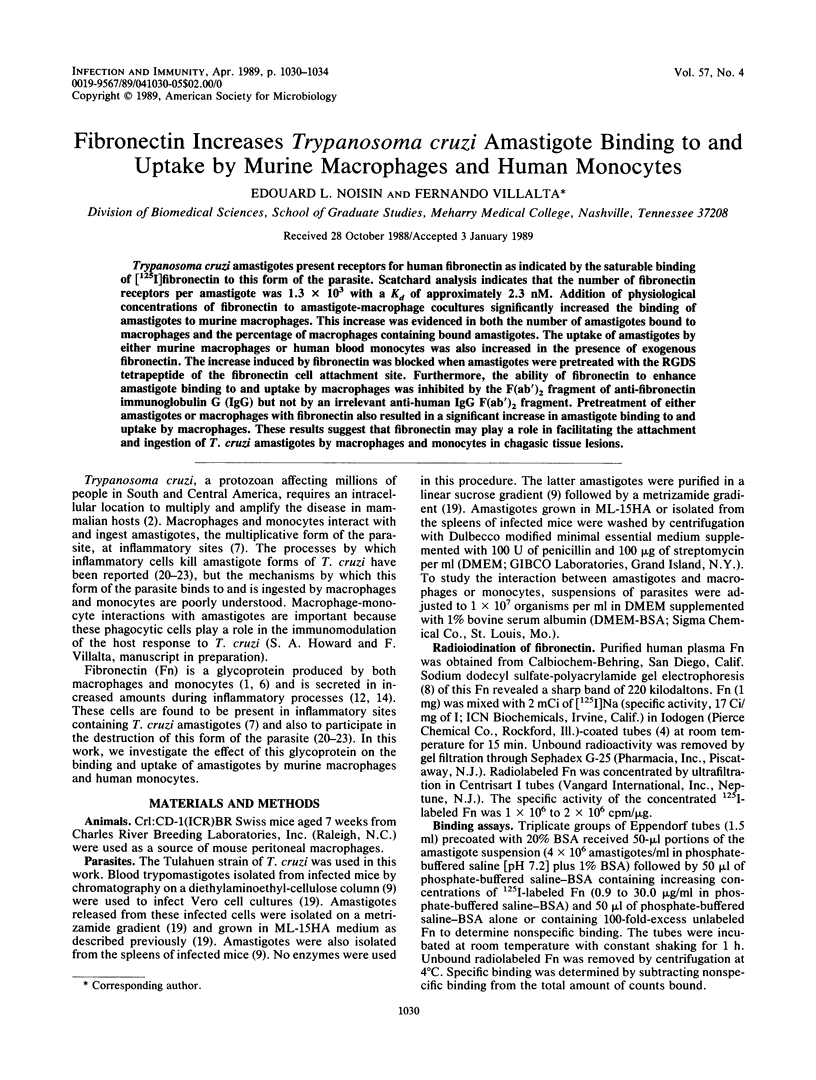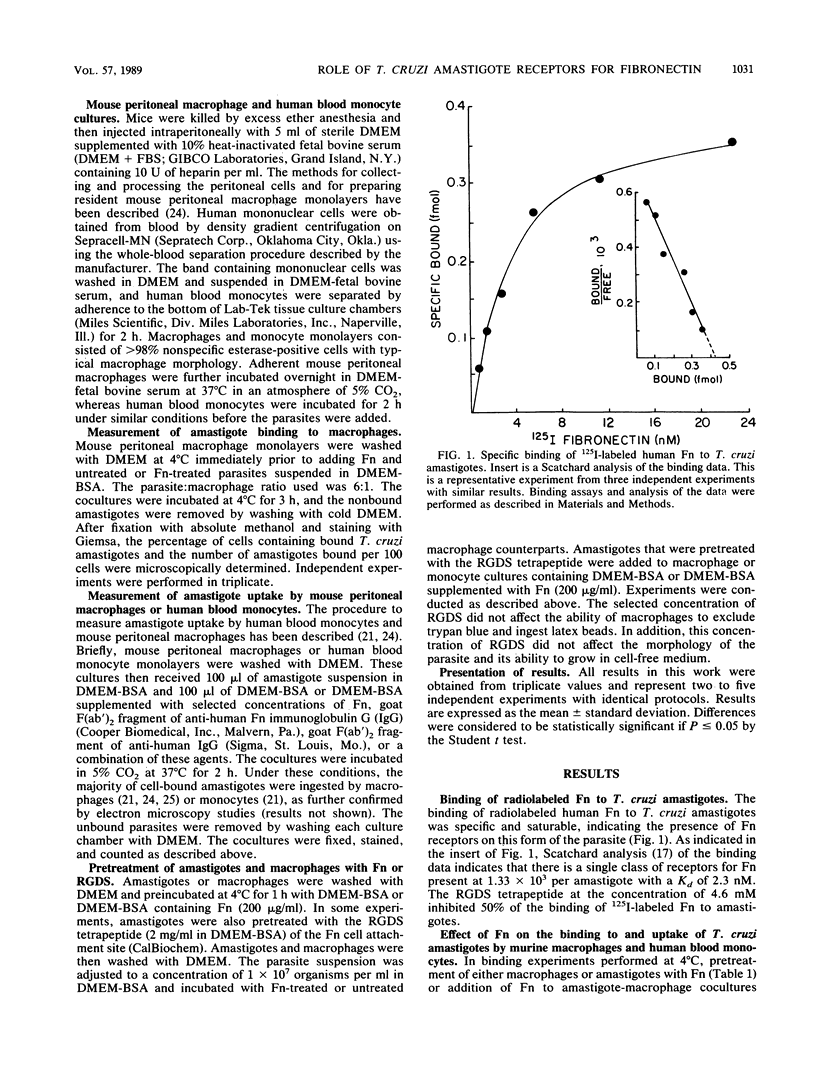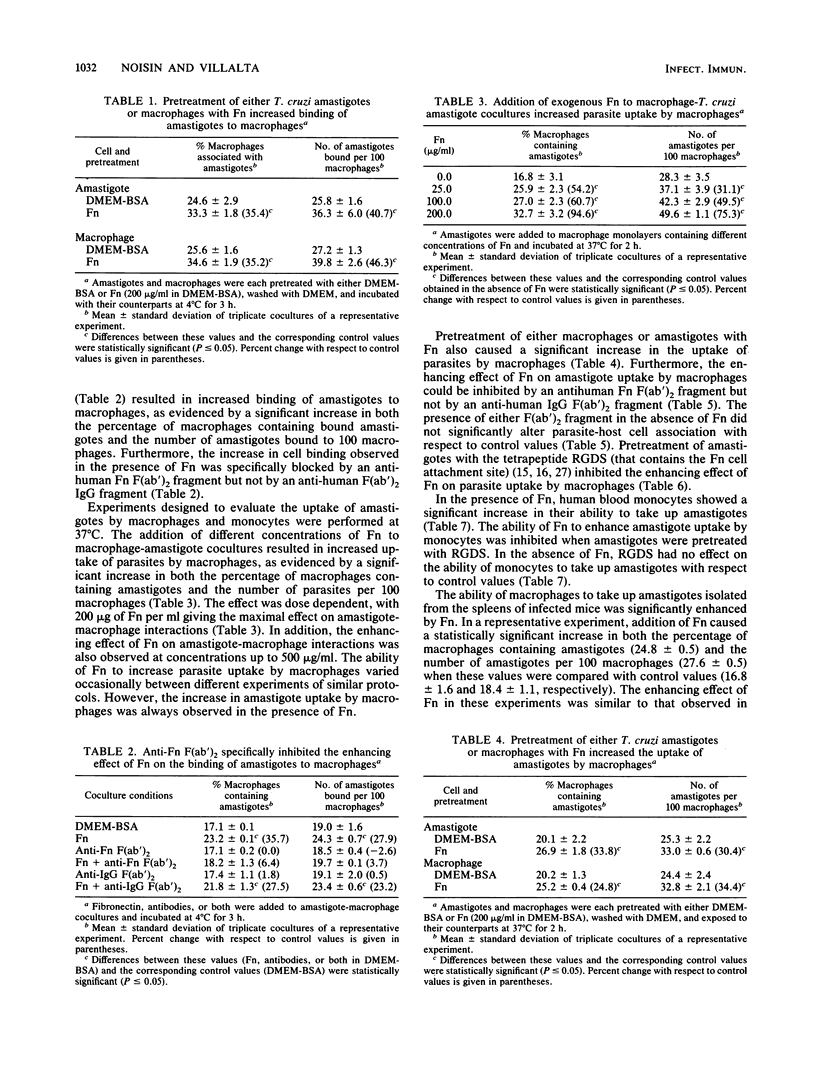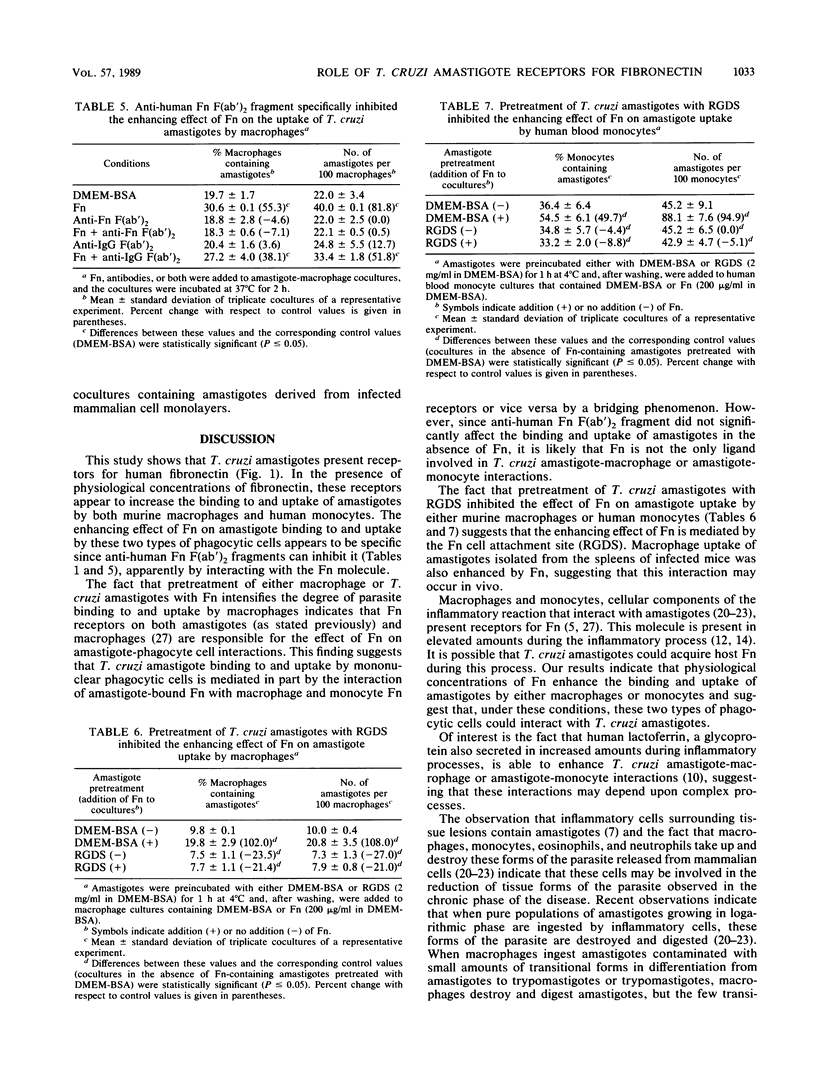Abstract
Trypanosoma cruzi amastigotes present receptors for human fibronectin as indicated by the saturable binding of [125I]fibronectin to this form of the parasite. Scatchard analysis indicates that the number of fibronectin receptors per amastigote was 1.3 x 10(3) with a Kd of approximately 2.3 nM. Addition of physiological concentrations of fibronectin to amastigote-macrophage cocultures significantly increased the binding of amastigotes to murine macrophages. This increase was evidenced in both the number of amastigotes bound to macrophages and the percentage of macrophages containing bound amastigotes. The uptake of amastigotes by either murine macrophages or human blood monocytes was also increased in the presence of exogenous fibronectin. The increase induced by fibronectin was blocked when amastigotes were pretreated with the RGDS tetrapeptide of the fibronectin cell attachment site. Furthermore, the ability of fibronectin to enhance amastigote binding to and uptake by macrophages was inhibited by the F(ab')2 fragment of anti-fibronectin immunoglobulin G (IgG) but not by an irrelevant anti-human IgG F(ab')2 fragment. Pretreatment of either amastigotes or macrophages with fibronectin also resulted in a significant increase in amastigote binding to and uptake by macrophages. These results suggest that fibronectin may play a role in facilitating the attachment and ingestion of T. cruzi amastigotes by macrophages and monocytes in chagasic tissue lesions.
Full text
PDF




Selected References
These references are in PubMed. This may not be the complete list of references from this article.
- Alitalo K., Hovi T., Vaheri A. Fibronectin is produced by human macrophages. J Exp Med. 1980 Mar 1;151(3):602–613. doi: 10.1084/jem.151.3.602. [DOI] [PMC free article] [PubMed] [Google Scholar]
- Brener Z. Biology of Trypanosoma cruzi. Annu Rev Microbiol. 1973;27:347–382. doi: 10.1146/annurev.mi.27.100173.002023. [DOI] [PubMed] [Google Scholar]
- Carvalho R. M., Meirelles M. N., de Souza W., Leon W. Isolation of the intracellular stage of Trypanosoma cruzi and its interaction with mouse macrophages in vitro. Infect Immun. 1981 Aug;33(2):546–554. doi: 10.1128/iai.33.2.546-554.1981. [DOI] [PMC free article] [PubMed] [Google Scholar]
- Fraker P. J., Speck J. C., Jr Protein and cell membrane iodinations with a sparingly soluble chloroamide, 1,3,4,6-tetrachloro-3a,6a-diphrenylglycoluril. Biochem Biophys Res Commun. 1978 Feb 28;80(4):849–857. doi: 10.1016/0006-291x(78)91322-0. [DOI] [PubMed] [Google Scholar]
- Hosein B., Bianco C. Monocyte receptors for fibronectin characterized by a monoclonal antibody that interferes with receptor activity. J Exp Med. 1985 Jul 1;162(1):157–170. doi: 10.1084/jem.162.1.157. [DOI] [PMC free article] [PubMed] [Google Scholar]
- Johansson S., Rubin K., Hök M., Ahlgren T., Seljelid R. In vitro biosynthesis of cold insoluble globulin (fibronectin) by mouse peritoneal macrophages. FEBS Lett. 1979 Sep 15;105(2):313–316. doi: 10.1016/0014-5793(79)80637-7. [DOI] [PubMed] [Google Scholar]
- Köberle F. Chagas' disease and Chagas' syndromes: the pathology of American trypanosomiasis. Adv Parasitol. 1968;6:63–116. doi: 10.1016/s0065-308x(08)60472-8. [DOI] [PubMed] [Google Scholar]
- Laemmli U. K. Cleavage of structural proteins during the assembly of the head of bacteriophage T4. Nature. 1970 Aug 15;227(5259):680–685. doi: 10.1038/227680a0. [DOI] [PubMed] [Google Scholar]
- Leon W., Villalta F., Queiroz T., Szarfman A. Antibody-induced capping of the intracellular stage of Trypanosoma cruzi. Infect Immun. 1979 Dec;26(3):1218–1220. doi: 10.1128/iai.26.3.1218-1220.1979. [DOI] [PMC free article] [PubMed] [Google Scholar]
- Lima M. F., Kierszenbaum F. Lactoferrin effects on phagocytic cell function. I. Increased uptake and killing of an intracellular parasite by murine macrophages and human monocytes. J Immunol. 1985 Jun;134(6):4176–4183. [PubMed] [Google Scholar]
- Ouaissi M. A., Afchain D., Capron A., Grimaud J. A. Fibronectin receptors on Trypanosoma cruzi trypomastigotes and their biological function. Nature. 1984 Mar 22;308(5957):380–382. doi: 10.1038/308380a0. [DOI] [PubMed] [Google Scholar]
- Owens M. R., Cimino C. D. Synthesis of fibronectin by the isolated perfused rat liver. Blood. 1982 Jun;59(6):1305–1309. [PubMed] [Google Scholar]
- Peyrol S., Ouaissi M. A., Capron A., Grimaud J. A. Trypanosoma cruzi: ultrastructural visualization of fibronectin bound to culture forms. Exp Parasitol. 1987 Feb;63(1):112–114. doi: 10.1016/0014-4894(87)90084-1. [DOI] [PubMed] [Google Scholar]
- Pick-Kober K. H., Münker D., Gressner A. M. Fibronectin is synthesized as an acute phase reactant in rat hepatocytes. J Clin Chem Clin Biochem. 1986 Aug;24(8):521–528. doi: 10.1515/cclm.1986.24.8.521. [DOI] [PubMed] [Google Scholar]
- Pierschbacher M. D., Ruoslahti E. Cell attachment activity of fibronectin can be duplicated by small synthetic fragments of the molecule. Nature. 1984 May 3;309(5963):30–33. doi: 10.1038/309030a0. [DOI] [PubMed] [Google Scholar]
- Pierschbacher M., Hayman E. G., Ruoslahti E. Synthetic peptide with cell attachment activity of fibronectin. Proc Natl Acad Sci U S A. 1983 Mar;80(5):1224–1227. doi: 10.1073/pnas.80.5.1224. [DOI] [PMC free article] [PubMed] [Google Scholar]
- Villalta F. V., Leon W. Effect of purification by DEAE-cellulose column on infectivity of Trypanosoma cruzi blood forms. J Parasitol. 1979 Feb;65(1):188–189. [PubMed] [Google Scholar]
- Villalta F., Kierszenbaum F. Effects of human colony-stimulating factor on the uptake and destruction of a pathogenic parasite (Trypanosoma cruzi) by human neutrophils. J Immunol. 1986 Sep 1;137(5):1703–1707. [PubMed] [Google Scholar]
- Villalta F., Kierszenbaum F. Growth of isolated amastigotes of Trypanosoma cruzi in cell-free medium. J Protozool. 1982 Nov;29(4):570–576. doi: 10.1111/j.1550-7408.1982.tb01338.x. [DOI] [PubMed] [Google Scholar]
- Villalta F., Kierszenbaum F. Host cell invasion by Trypanosoma cruzi: role of cell surface galactose residues. Biochem Biophys Res Commun. 1984 Feb 29;119(1):228–235. doi: 10.1016/0006-291x(84)91642-5. [DOI] [PubMed] [Google Scholar]
- Villalta F., Kierszenbaum F. Role of cell surface mannose residues in host cell invasion by Trypanosoma cruzi. Biochim Biophys Acta. 1983 Dec 7;736(1):39–44. doi: 10.1016/0005-2736(83)90167-0. [DOI] [PubMed] [Google Scholar]
- Villalta F., Kierszenbaum F. Role of inflammatory cells in Chagas' disease. I. Uptake and mechanism of destruction of intracellular (amastigote) forms of Trypanosoma cruzi by human eosinophils. J Immunol. 1984 Apr;132(4):2053–2058. [PubMed] [Google Scholar]
- Villalta F., Kierszenbaum F. Role of inflammatory cells in Chagas' disease. II. Interactions of mouse macrophages and human monocytes with intracellular forms of Trypanosoma cruzi: uptake and mechanism of destruction. J Immunol. 1984 Dec;133(6):3338–3343. [PubMed] [Google Scholar]
- Villalta F., Kierszenbaum F. Role of polymorphonuclear cells in Chagas' disease. I. Uptake and mechanisms of destruction of intracellular (amastigote) forms of Trypanosoma cruzi by human neutrophils. J Immunol. 1983 Sep;131(3):1504–1510. [PubMed] [Google Scholar]
- Wirth J. J., Kierszenbaum F. Fibronectin enhances macrophage association with invasive forms of Trypanosoma cruzi. J Immunol. 1984 Jul;133(1):460–464. [PubMed] [Google Scholar]
- Wright S. D., Meyer B. C. Fibronectin receptor of human macrophages recognizes the sequence Arg-Gly-Asp-Ser. J Exp Med. 1985 Aug 1;162(2):762–767. doi: 10.1084/jem.162.2.762. [DOI] [PMC free article] [PubMed] [Google Scholar]


